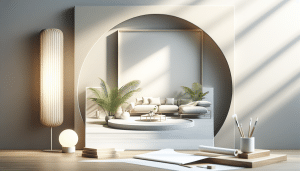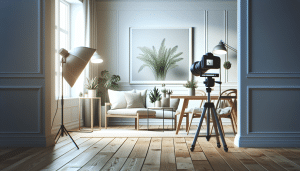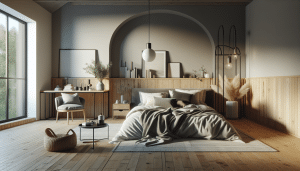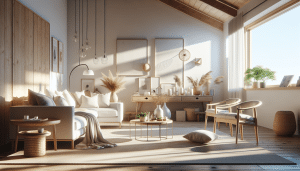Why Minimalist Design Trends Inspire Modern Living
Samantha Lee September 27, 2025
Minimalist design is captivating more people who hope for simplicity and focus at home. Explore the power of clean lines, calming spaces, and intentional choices that reflect modern lifestyle and entertainment needs. This guide reveals how minimalism reshapes daily comfort and creative living.
The Philosophy Behind Minimalist Interiors
Minimalist design invites people to strip away clutter, focusing attention on what matters most in their living spaces. This approach is rooted in the idea that less can indeed be more, fostering a calm and purposeful environment. As interest in peaceful spaces rises, minimalist interiors have quickly become a reflection of smart lifestyle choices. Clean surfaces, ample natural light, and carefully selected furnishings are hallmarks of this design movement. Minimalism is not about deprivation; it’s about clarity and intention, supporting everyday wellbeing for those who want practical, beautiful surroundings.
Philosophically, minimalist interiors draw from traditions like Zen, focusing on tranquility and the careful use of materials. In entertainment areas, minimalist designs encourage flexible spaces for relaxation, gatherings, or solo activities. Extra attention is paid to how each item fulfills a purpose. This selective curation means every decor piece, from lighting to art, is chosen for its contribution to the whole. The result is a living area that feels open, inviting, and free from distraction, perfect for both unwinding and socializing.
Psychological research suggests that tidy, uncluttered spaces can lower stress levels and improve focus, making minimalist environments a smart choice for modern homes (Source: https://www.apa.org/news/press/releases/stress/2015/impact). By removing visual and physical excess, inhabitants enjoy an atmosphere that supports clear thinking and stress reduction. Minimalism isn’t just an aesthetic – it’s a way of thinking about what truly enriches everyday life and entertainment. Guided by intentional simplicity, more people are finding their ideal balance between comfort and style.
Color Palettes and Materials That Shape a Minimalist Home
Color is a cornerstone of minimalist spaces. Typically, designers favor whites, soft grays, and muted earth tones that create a sense of airiness. These soothing colors help rooms feel open and gently reflect natural light, enhancing the feeling of serenity. For many, this type of color palette offers a welcome escape from the sensory overload of technology and daily demands. Such a setting becomes an ideal backdrop for both quiet nights in and memorable gatherings with friends.
The use of natural materials is also a defining characteristic of minimalist interiors. Think oak flooring, wool throws, ceramic accents, and linen textiles. Each material is selected for its durability, beauty, and ability to age gracefully over time. Sustainability-conscious homeowners appreciate these choices, knowing they align with environmentally responsible principles (Source: https://www.architecture.com/knowledge-and-resources/resources-landing-page/sustainable-architecture). This blend of restraint and comfort enhances both visual and tactile enjoyment within the space.
Subtle contrast is key. Minimalist designers often introduce black accents or textured finishes to add interest while maintaining visual calm. This approach can be seen in popular open-plan living rooms, where a single bold chair or a statement lamp draws the eye without overwhelming the senses. Materials like glass and steel pair seamlessly with wood and cotton, proving that simplicity can feel both luxurious and welcoming. The cohesion of these elements often leads to more mindful consumption, as homeowners prioritize quality over quantity.
Decluttering and Organization for Lasting Minimalism
Real-world minimalism isn’t about empty rooms. Instead, it’s about making thoughtful decisions that reduce clutter and streamline daily routines. Storage solutions fit seamlessly into this philosophy, offering practical ways to keep essentials within reach yet out of sight. Built-in shelving, multi-purpose furniture, and open closets are all trends that maximize space while maintaining a clean look. Many are surprised how effective the ‘one-in, one-out’ method is for keeping possessions in check and energy positive.
Organizational techniques like the KonMari method encourage people to retain only items that inspire joy or serve a purpose (Source: https://greatergood.berkeley.edu/article/item/is_clutter_stressing_you_out). In minimalist households, form and function blend so seamlessly that even daily-use objects can become part of the décor. Hidden drawers, stackable bins, and wall-mounted racks make storing everything from entertainment gadgets to daily paperwork effortless. By creating designated spots for belongings, it becomes easier to maintain order and a peaceful ambiance over the long term.
Minimalism extends beyond décor, affecting lifestyle and family dynamics. Fewer possessions often mean that shared living areas are less chaotic and more welcoming for both residents and guests. When homes feel organized, the simple act of hosting movie nights, board games, or casual dinners is more enjoyable. Streamlined living encourages mindful entertainment choices, helping households create truly memorable experiences that aren’t overshadowed by physical mess or distractions.
Entertaining and Socializing With a Minimalist Mindset
Minimalism doesn’t mean giving up gatherings or fun. Instead, it shapes how people host, entertain, and enjoy time at home. Open layouts, unobstructed surfaces, and flexible seating arrangements create a welcoming environment for guests. When every element is intentional, it’s easier to shift between a cozy movie marathon, a festive dinner, or a friendly discussion over coffee. As a result, minimalism supports both spontaneous get-togethers and planned occasions, adapting easily to the flow of modern social life.
Technology integration also plays a big role in minimalist entertaining. Many opt for wireless sound systems, hidden projectors, and smart lighting to minimize visible clutter. Seamless tech can transform a simple living room into a media hub for music, streaming, or interactive experiences, without sacrificing style. This shift makes it easier for families and friends to connect in a space that feels streamlined yet fully equipped (Source: https://www.wired.com/story/smart-home-products-streamlined-living/).
Minimalist hosting philosophies often embrace high-quality, versatile serveware and fewer, carefully prepared dishes. The focus is on genuine connection rather than elaborate presentations or excessive options. This way, both hosts and guests can relax and focus on meaningful conversation or shared activities. Research links shared meals with stronger social bonds, so minimalist entertaining helps foster those connections while keeping stress low (Source: https://www.ncbi.nlm.nih.gov/pmc/articles/PMC6478375/).
Practical Guides to Achieving Minimalism in Any Home
Getting started with minimalism can seem daunting, yet it’s accessible to nearly everyone. Begin with a single room or even just a closet. Evaluate each item for its purpose or joy it brings, letting go of what’s unnecessary. This simplicity can quickly spread through the rest of the home, influencing how you design, decorate, and even purchase things for lifestyle and entertainment.
For renters and those on a budget, minimalism remains practical. Simple fixes—like neutral slipcovers, removable storage, or low-maintenance plants—can transform spaces with minimal expense. Focus on versatile furniture, such as stackable chairs or nesting tables, which offer flexible arrangements for guests and daily relaxation. Minimalist aesthetics can be achieved through affordable DIY projects found on non-profit or university design sites (Source: https://www.huduser.gov/portal/pdredge/pdr-edge-featd-article-011321.html).
Many find that documenting the process—through journals or photos—helps maintain motivation and guide future reorganization decisions. As spaces and routines change, people often experience improved wellbeing and satisfaction with their environment. The journey toward minimalism is unique and personal, allowing creative interpretation and lasting benefits physically, emotionally, and socially.
The Enduring Appeal of Minimalist Design for Modern Lifestyles
Minimalism is not a fleeting trend but an evolving approach that adapts beautifully to changing needs over time. With its foundation in simplicity, efficiency, and evidence-based wellbeing, minimalist design endures because it makes daily life feel lighter and more intentional. Many individuals credit streamlined interiors with helping them stay focused, relaxed, and engaged as entertainment choices and social habits evolve.
Unlike styles locked to one era, minimalism is a blank canvas, easily tailored with new materials, bold artwork, or seasonal accents. People often enjoy refreshing spaces without starting from scratch, giving rooms a sense of renewal while sticking to key minimalist principles. This quality is especially important in fast-moving cities, where adaptability counts as much as style.
Overall, minimalist design continues to influence everything from online content to home product innovation and wellness movements (Source: https://www.psychologytoday.com/us/blog/smart-habits/201901/the-mental-health-benefits-minimalism). Its staying power comes from its ability to enrich personal and social lives, making every moment at home feel more meaningful, comfortable, and memorable. Explore further to find your own interpretation of what minimalist living can offer in your world.
References
1. American Psychological Association. (2015). Stress in America: Paying with Our Health. Retrieved from https://www.apa.org/news/press/releases/stress/2015/impact
2. Royal Institute of British Architects. (n.d.). Sustainable Architecture. Retrieved from https://www.architecture.com/knowledge-and-resources/resources-landing-page/sustainable-architecture
3. Greater Good Science Center at UC Berkeley. (n.d.). Is Clutter Stressing You Out? Retrieved from https://greatergood.berkeley.edu/article/item/is_clutter_stressing_you_out
4. Wired. (2020). Smart Home Products for Streamlined Living. Retrieved from https://www.wired.com/story/smart-home-products-streamlined-living/
5. National Institutes of Health. (2019). Eating Together as a Family. Retrieved from https://www.ncbi.nlm.nih.gov/pmc/articles/PMC6478375/
6. U.S. Department of Housing and Urban Development. (2021). Affordable Design Strategies for Living Spaces. Retrieved from https://www.huduser.gov/portal/pdredge/pdr-edge-featd-article-011321.html







